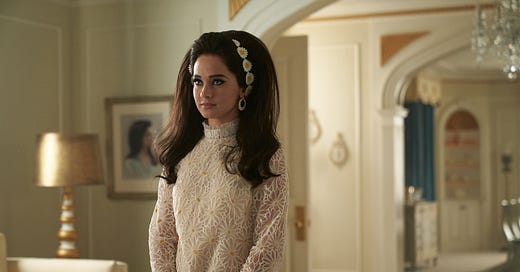The opening shot of Priscilla, the new film from Sofia Coppola, based on Priscilla Presley’s memoir Elvis and Me, is an extreme close-up of the titular Priscilla drawing a cat eye; so naturally, because my brain is broken, I immediately thought, “draw the cat eye sharp enough to kill a man.”
Right away (after Taylor Swift left my mind), something felt off in the edit. There is simply something incorrect about the rhythm of the film. This feeling never left me; there are few shots in the film that are held for long enough, giving the film a jagged, ragged disjointedness. In fact, the first thing I did after the movie ended was look up who edited it, and I was low-key surprised to find that it was still cut by Coppola’s longtime editor, Sarah Flack. I was like, so what the fuck is going on here?

Coppola likes to withhold close-ups in her work, keeping her protagonists at arm’s length, which gives them a certain mythic unknowability—can we, the audience, ever get to an absolute truth about Lux Lisbon or Marie Antoinette? There is a constant tension between longer, objective scenes illustrating the inscrutability of women, and subjective pop montages, sudden explosions of pure emotion in which we learn what her characters really feel beneath their placid, often seemingly shallow surface.
The entire Sofia Coppola project is about obfuscating narrative specifics in order to get to a deeper emotional truth: think of the ending of Lost in Translation where the audience doesn’t get to hear what Bill Murray whispers in Scarlett Johansson’s ear as they say goodbye. Strangely, there is no unknowability in Priscilla. Both the narrative and Priscilla’s emotions are frustratingly plain. And the audience, because of the editing issue, isn’t actually along for the ride.
There is a shot of Priscilla arriving to either Graceland or Los Angeles in the middle of a party and Elvis is at the pool table. (I think it’s the former, when she initially moves to Graceland, but if someone can remember exactly, please let me know. I rarely write about movies I cannot pull up at home to answer my questions! I’m being brave and growing.) Priscilla walks through the crowded room toward Elvis, and there’s a brief shot from behind Priscilla, on Elvis, tracking behind her as she walks closer to him. The shot quickly returns to the front of Priscilla’s face, and then to a closer shot on Elvis.
That moment of anticipation, Priscilla reuniting with the person she loves, would be much more effective if we had stayed on that wide tracking shot for the entirety of that moment, following behind Priscilla. All of Priscilla’s attention at that moment is on Elvis, and so should the audience’s be. The cuts only put more of a distance between us. I was not with her, and I should be with her.
This succession of shots really stuck with me, because it’s a problem. I wonder if a lot of the film was only editable in this way, lots of sharp quick shots, forgoing the lingering shots of her previous films, because of the performance of one Jacob Elordi as Elvis Presley, who is awful in this film. Coppola’s Elvis is intended to be seen as one of her oafish male characters, King Louis XVI of France with his clock obsession and inability to fuck, but Elordi didn’t realize he was supposed to be the butt of a joke. Poor thing. Could they be cutting around him? I’m willing to speculate that the answer is yes, and that they didn’t want it to be obvious so they cut even the scenes without Elvis similarly, to make it feel like it was on purpose. So I think that’s one issue.
We’ll get back to Elordi later, or maybe we won’t—he already has enough in this world. I would instead like to also speculate about how much control Priscilla Presley, herself, had over the project—both over the script and over the final edit. She’s listed in the credits as an Executive Producer, which is not a tightly regulated credit; on the one hand, it could be purely a contractual vanity credit, but it could also be that she had approvals over what was or wasn’t depicted, and how those things were depicted. Drop the contract, Sofe!
I think it’s highly likely that Presley wanted her story to be abundantly clear: exactly what she went through, exactly how many times Elvis accidentally hit her, exactly how she felt at every step of the way. Which is in direct opposition to what Coppola has been interested for the past quarter of a century. The mystery is the whole thing. So that’s the other issue.
A filmmaker can never fully control what happens when they make a film, and these two problems working in concert are a perfect storm to overwhelm what actually does work about the film: Cailee Spaeny’s nuanced performance as Priscilla; the gorgeous cinematography; the music. It’s a shame, really—this is the perfect material to be a masterpiece. But instead it’s Coppola’s Gangs of New York.
We’ll get back to #scorgayse blogging next week, but I wanted to review Priscilla this week as a prelude to announce that starting next week, I’ll be reviewing all of Sofia Coppola’s work as well—behind the paywall! The plan is to release a Coppola review on Tuesdays to paid subscribers and we’ll continue with Scorsese every Friday, but please don’t hold me to this schedule, I’m weak and not very bright... I’m an Italian filmmaker who likes boys, so we will continue, for the time being, only covering Italian filmmakers who like boys xx





hadn’t considered the rhythm is an accident due to cutting around...now i’m convinced it’s real!!!
Very interesting-- I wish more film critics would talk about editing.